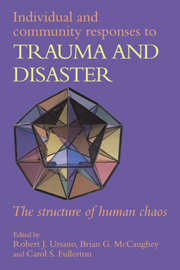Book contents
- Frontmatter
- Contents
- List of contributors
- Foreword
- Preface
- Part I Introduction
- Part II The nature of traumatic stress
- Part III The role of psychosocial context in responses to trauma and disasters
- 8 Social support and perceived control as moderators of responses to dioxin and flood exposure
- 9 Debriefing following traumatic exposure
- 10 Relocation stress following natural disasters
- 11 Group reactions to trauma: an avalanche accident
- 12 Community responses to disaster: the Gander plane crash
- Part IV Responses to trauma across the life cycle
- Part V Conclusions
- Index
11 - Group reactions to trauma: an avalanche accident
from Part III - The role of psychosocial context in responses to trauma and disasters
Published online by Cambridge University Press: 13 October 2009
- Frontmatter
- Contents
- List of contributors
- Foreword
- Preface
- Part I Introduction
- Part II The nature of traumatic stress
- Part III The role of psychosocial context in responses to trauma and disasters
- 8 Social support and perceived control as moderators of responses to dioxin and flood exposure
- 9 Debriefing following traumatic exposure
- 10 Relocation stress following natural disasters
- 11 Group reactions to trauma: an avalanche accident
- 12 Community responses to disaster: the Gander plane crash
- Part IV Responses to trauma across the life cycle
- Part V Conclusions
- Index
Summary
Avalanches have been a threat to humankind for as long as man has lived and travelled in mountainous areas. Only gradually over the centuries, and through devastating experiences were safe paths found through mountainous areas. Today, as many more areas are available to people less qualified and trained to master and judge the mountains, the danger of avalanches is much greater. This is particularly true in countries where cross-country skiing and alpine sports are popular. The majority (60%) of avalanche victims in Europe are skiers who usually are caught in avalanches when skiing outside marked boundaries. Other victims are caught in avalanches while merely travelling through a danger area by car or working in an avalanche area. As a consequence, huge sums of money have been invested in safety measures along the most travelled and vulnerable routes.
Avalanches are not only caused by sliding snow. Extremely dangerous rock and mud avalanches sometimes follow earthquakes, flooding, or heavy rain. These avalanches can cause disasters in areas where people are not expecting or prepared for such devastation. Volcanic eruptions with lava flow can bury whole communities. Avalanches may lead to other disasters such as floods caused by rivers damming-up, e.g. in Columbia, 1983 when 30 000 people died (Baskett & Weller, 1988; Lima et al., 1987).
In this chapter, I will concentrate on the physical, psychological and sociological hazards of snow avalanches, as it would be too ambitious to describe responses to all types of avalanches in a single chapter.
- Type
- Chapter
- Information
- Individual and Community Responses to Trauma and DisasterThe Structure of Human Chaos, pp. 248 - 266Publisher: Cambridge University PressPrint publication year: 1994
- 9
- Cited by



